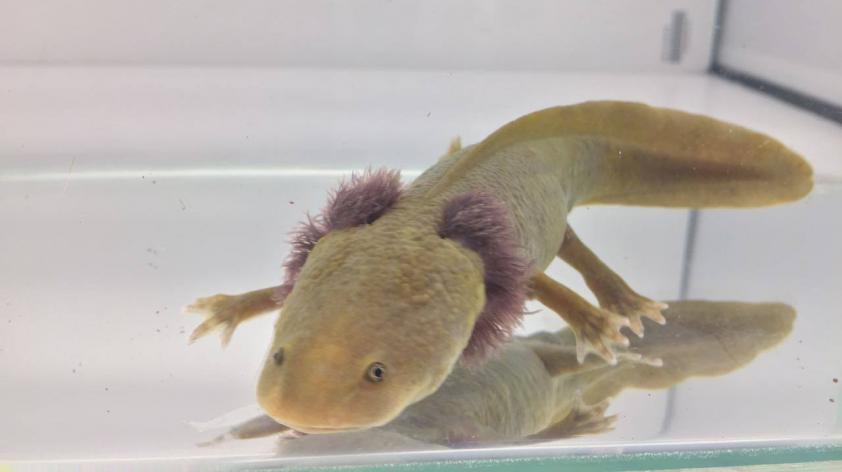
In search of an iconic Mexican salamander
“Went to the convent to discuss freezing salamander sperm with a Mexican nun,” read a tweet from my friend and colleague, Dr. Kim Terrell of Memphis Zoo. Earlier this month, the two of us embarked on a journey to lay the ground work for a new community-based, science program to help protect Mexico’s endangered salamanders, known by the native Náhuatl dialect as axolotls (or ajolotes in Spanish). Our key partners in this effort were Ana Santiago and Véronica Rosas, Research Professors at the University of Guadalajara and women who have worked in several protected areas of western Mexico studying the ecology and diversity of forests, in search of rare amphibians. Accompanied by two of her undergraduate students, Aldo Dávalos and Antonio Najar, Ana led us through the massive pine-oak forests of Sierra de Quila to begin scouting out sites for future amphibian research projects.
After two days filled with turtles, tarantulas, and tiny frogs that could fit on your thumbnail, the first part of our mission was complete. We packed up the truck and headed east towards the tiny town of Pátzcuaro, in search of an extraordinary group of nuns and a nearly extinct salamander. Over the course of this trip, I discovered that the axolotls of Mexico (scientifically known as Ambystomids) are one of the least studied amphibian families in the world. These large, plump salamanders are endowed with elaborate, feathery gills that disappear gradually as they make the transition to adulthood. Most people are familiar with the Mexican axolotl, Ambystoma mexicanum, a species that is commonly kept as a pet and has been extensively studied for its remarkable ability to regenerate body parts. Ironically, this amphibian “lab rat” is the only axolotl species that has become extinct in the wild, largely due to habitat loss.
The inbred, albino axolotls that are found in labs and pet stores barely resemble their wild ancestors and would never survive in nature. Yet the streams and lakes of Mexico still provide refuge for19 other axolotl species (with a newly-discovered 20th species currently awaiting official classification). Mexico is third on the list of countries classified as mega diverse because it contains 9 of the 11 ecosystems found on the planet.
On a global scale, Mexico is fourth place for amphibian biodiversity, (https://youtu.be/Dv6h-C3MgWg) and has the largest diversity of salamander species in the world, all of which are considered vulnerable or critically endangered (IUCN, 2017). While these species are federally protected in Mexico, efforts to study and protect wild populations are limited. Understanding the basic biology of these species and how they interact with their environment is an essential first step for any potential restoration program in the future.
As with many fauna, the threats facing Mexico’s axolotl species are linked to a growing human population, including deforestation (for both legal and illegal purposes) and poaching for the pet trade. However, there is still hope for these rare salamanders. Many species have found refuge in Mexico’s protected areas, and there is a growing movement to study and conserve axolotl salamanders, with university researchers like Ana Santiago leading the charge. Ana knows firsthand the challenges and triumphs that come with axolotl conservation.
In 2008, she and her collaborators discovered a population of yellow-peppered salamanders (Ambystoma flavipiperatum), a species thought to be extinct, in Sierra de Quila. Now Ana is planning the next step in the conservation of yellow-peppered salamanders – establishing frozen sperm banks and captive breeding colonies to provide ‘insurance’ against the loss of this sole remaining population. I came to know of Ana through another salamander enthusiast, Manuel Gonzalez DVM, who I met in 2015 at a conference on the cryopreservation of Mexican flora and fauna. Since finishing his masters at the University of Guadalajara, Manuel along with his wife Karen, have established a captive breeding colony with which they hope to develop husbandry and cryopreservation protocols for a number of salamander species. “Ambystolab” is the official name of their lab, an operation that houses 6 species of native salamanders. Together with his wife and two daughters, Manuel operates and finances this facility by working night shifts at a local animal ER.
Manuel also introduced me to someone I honestly never thought I would meet at a conference on cryopreservation, or guess would be a salamander breeder – Sister Ofelia of the Order of Sisters of the Immaculate Health.
In my last blog I spoke of the nuns and their salamander sanctuary, known as the Uma Jimbani Erandi (which means a “new dawn” in the local Purhepecha dialect) located near the shores of lake Pátzcuaro. Here, a group of nuns faithfully (and single-handedly) maintains a native breeding population known as the Lake Pátzcuaro Salamander, Ambystoma dumerilii. It had been two years since Sister Ofelia and I had last met. Kim, Ana and myself arrived at the doors of the convent, descending unexpectedly on the busy nuns. Announcing our arrival in anticipation had been impossible but remembering our last meeting Ofelia agreed to meet with, and show us her salamander colony. We discussed the possibility of collaborating with the sisters and with Manuel to develop an amphibian biobank for A. dumerilii and other species.
This story does not quite have a conclusion just yet as there is still much to discuss and plan. What I can say is that when we left the convent that day the three of us had a sense of excitement and elation. Our trip had been a success in ways I hadn’t imagined, an amazing experience full of the prospect of new friendships and collaborations between groups of people from very different walks of life but united by a common passion, to save the endangered and iconic salamanders of Mexico.













